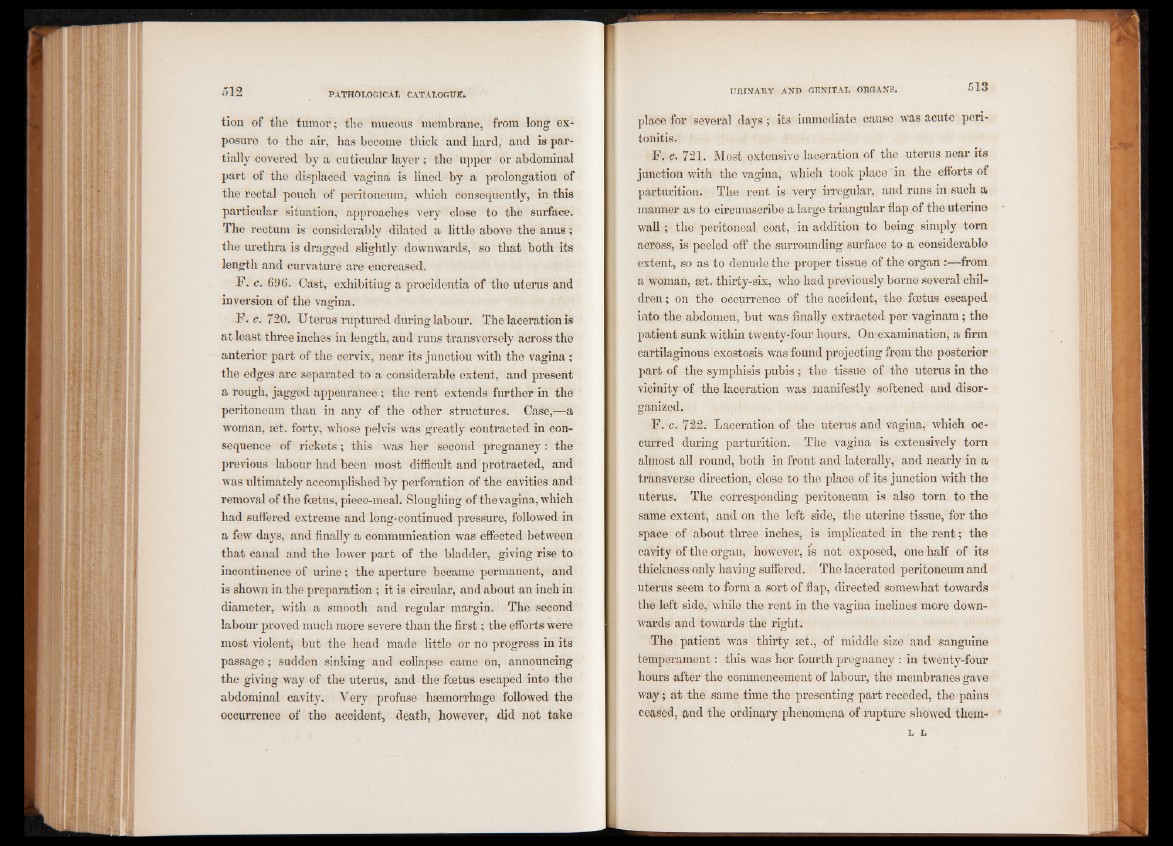
tion of the tumor; the mucous membrane, from long exposure
to the air, has become thick and hard, and is partially
covered by a cuticular layer ; the upper or abdominal
part of the displaced vagina is lined by a prolongation of
the rectal pouch of peritoneum, which consequently, in this
particular situation, approaches very close to the surface.
The rectum is considerably dilated a little above the anus ;
the urethra is dragged slightly downwards, so that both its
length and curvature are encreased.
F. c. 696. Oast, exhibiting a procidentia of the uterus and
inversion of the vagina.
F. c. 720. Uterus ruptured during labour. The laceration is
at least three inches in length, aud runs transversely across the
anterior part of the cervix, near its junctiou with the vagina ;
the edges are separated to a considerable extent, and present
a rough, jagged appearance ; the rent extends further in the
peritoneum than in any of the other structures. Case,-—a
woman, æt. forty, whose pelvis was greatly contracted in consequence
of rickets; this was her second pregnancy : the
previous labour had been most difficult and protracted, and
was ultimately accomplished by perforation of the cavities and
removal of the foetus, piece-meal. Sloughing of the vagina, which
had suffered extreme and long-continued pressure, followed in
a few days, and finally a communication was effected between
that canal and the lower part of the bladder, giving rise to
incontinence of urine ; the aperture became permanent, and
is shown in the preparation ; it is circular, and about an inch in
diameter, with a smooth and regular margin. The second
labour proved much more severe than the first ; the efforts were
most violent; but the head made little or no progress in its
passage ; sudden sinking and collapse came on, announcing
the giving way of the uterus, and the foetus escaped into the
abdominal cavity. Very profuse hæmorrhage followed the
occurrence of the accident, death, however, did not take
place for several days; its immediate cause was acute peritonitis.
F. c. 721. Most extensive laceration of the uterus near its
junction with the vagina, which took place in the efforts of
parturition. The rent is very irregular, and runs in such a
manner as to circumscribe a large triangular flap of the uterine
wall; the peritoneal coat, in addition to being simply torn
across, is peeled off the surrounding surface to a considerable
extent, so as to denude the proper tissue of the organ :—from
a woman, mt. thirty-six, who had previously borne several children
; on the occurrence of the accident, the foetus escaped
into the abdomen, but was finally extracted per vaginam; the
patient sunk within twenty-four hours. On examination, a firm
cartilaginous exostosis was found projecting from the posterior
part of the symphisis pubis ; the tissue of the uterus in the
vicinity of the laceration was manifestly softened and disorganized.
F. c. 722. Laceration of the uterus and vagina, which occurred
during parturition. The vagina is extensively torn
almost all round, both in front and laterally, and nearly in a
transverse direction, close to the place of its junction with the
uterus. The corresponding peritoneum is also torn to the
same extent, and on the left side, the uterine tissue, for the
space of about three inches, is implicated in the rent; the
cavity of the organ, however, is not exposed, one half of its
thickness only having suffered. The lacerated peritoneum and
uterus seem to form a sort of flap, directed somewhat towards
the left side, while the rent in the vagina inclines more downwards
and towards the right.
The patient was thirty set., of middle size and sanguine
temperament: this was her fourth pregnancy : in twenty-four
hours after the commencement of labour, the membranes gave
way; at the same time the presenting part receded, the pains
ceased, and the ordinary phenomena of rupture shewed them-
L L